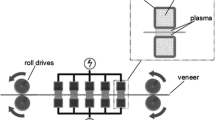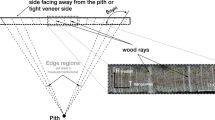Abstract
High moisture content western hemlock veneer was modified using viscoelastic thermal compression (VTC) technology with an integrated drying stage. VTC is a type of thermo-hydro-mechanical treatment. This project determined the influence of five processing parameters on properties of VTC lamina. VTC processing significantly increased the mechanical properties of veneer, which mainly depended on the degree of compression. However, moisture-induced thickness swell increased substantially depending on the degree of compression and venting time. Increasing process temperature increased mass loss. Integrating the drying step improved process efficiency and eliminated drying defects. Process optimization was different depending on the desire to increase mechanical properties or increase dimensional stability. Statistical models were developed to predict properties of VTC treated products and drying time. This project will reduce the cost of VTC technology and provide guidance to design commercial manufacturing processes.
Zusammenfassung
Western Hemlock Furnier mit hohem Feuchtegehalt wurde mittels viskoelastisch-thermischem Verdichtungsverfahren (VTC), eine Art thermo-hydromechanischer Prozess, und mit integrierter Trocknungsstufe behandelt. In dieser Studie wurde der Einfluss von fünf Prozessparametern auf die Eigenschaften von VTC modifizierten Furnieren untersucht. Durch das VTC-Verfahren wurden die mechanischen Eigenschaften von Furnier im Wesentlichen als Folge der Verdichtung signifikant verbessert. Jedoch nahm die feuchtebedingte Dickenquellung in Abhängigkeit des Verdichtungsgrades und der Freisetzungsdauer des Dampfdrucks erheblich zu. Eine Erhöhung der Prozesstemperatur führte zu erhöhtem Masseverlust. Durch Einbindung der Trocknungsstufe konnte die Prozesseffizienz verbessert und Trocknungsfehler ausgeschlossen werden. Prozessoptimierung unterschied sich je nachdem ob die mechanischen Eigenschaften oder die Dimensionsstabilität verbessert werden sollten. Es wurden statistische Modelle zur Vorhersage der Eigenschaften von VTC-behandelten Produkten und der Trocknungszeit entwickelt. Diese Studie senkt die Kosten des VTC-Verfahrens und liefert eine Anleitung zur Entwicklung kommerzieller Produktionsprozesse.



Similar content being viewed by others
References
APA (2009) Voluntary product standard PS-1-09 structural plywood, APA—the engineered wood association. Tacoma, Washington
ASTM D 1037-99 (2006) Standard test methods for evaluating properties of wood-based fiber and particle panel materials. American Society for Testing Materials, Philadelphia
Bao FC, Jiang ZH, Jiang XM (1998) Comparative studied on wood properties of juvenile vs. mature wood and plantation vs. natural forest of main plantation tree species in china. Scientia Silvae Sinicae 34(2):63–75
FAO (2010) Global forest resources assessment. FAO forestry paper 163, food and agriculture. Organization of the United Nations, Rome, p 340
Gunduz G, Korkut S, Sevim KD (2008) The effects of heat treatment on physical and technological properties and surface roughness of Camiyanı black pine (Pinus nigra Arn. subsp. pallasiana var. pallasiana) wood. Bioresour Technol 99(7):2275–2280
Hernández RE, Pontin M (2006) Shrinkage of three tropical hardwoods below and above the fiber saturation point. Wood Fiber Sci 38(3):474–483
Kamke FA (2006) Densified radiata pine for structural composites. Maderas Cienciay tecnología 8(2):83–92
Kamke FA, Kutnar A (2010) Transverse compression behavior of wood in saturated steam at 150–170 °C. Wood Fiber Sci 42(3):377–387
Kamke FA, Rathi V (2009) Modified hybrid poplar for structural composites. In: Proceedings of 4th European Conference on wood modification, April 27–29, Stockholm, Sweden, pp 397–400
Kamke FA, Rathi VM (2011) Apparatus for viscoelastic thermal compression of wood. Eur J Wood Prod 69(3):483–487
Kamke FA, Rautkari L (2009) Modified wood veneer for structural applications. In: Proceedings of 4th International Symposium on Veneer processing and products (ISVPP), May 24–27, Espoo, Finland, pp 207–212
Kamke FA, Sizemore H (2008) Viscoelastic thermal compression of wood. US Patent: 7404422. July 29, 2008
Korkut S, Guller B (2008) The effects of heat treatment on physical properties and surface roughness of red-bud maple (Acer trautvetteri Medw.) wood. Bioresour Technol 99(8):2846–2851
Korkut S, Akgül M, Dündar T (2008) The effects of heat treatment on some technological properties of Scots pine (Pinus sylvestris L.) wood. Bioresour Technol 99:1861–1868
Kutnar A, Kamke FA (2010) Densified wood for green composites. In: Willems F, Moens P (eds) Green composites: properties, design and life cycle assessment. Nova Science Publishers, Hauppauge, pp 197–204
Kutnar A, Kamke FA (2012) Compression of wood under saturated steam, superheated steam, and transient conditions at 150 °C, 160 °C, and 170 °C. Wood Sci Technol 46:73–88
Kutnar A, Kamke FA, Sernek M (2009) Density profile and morphology of viscoelastic thermal compressed wood. Wood Sci Technol 43:57–68
Lv JX (2002) Strengthen the research on plantation wood to reach national goal. China Wood-based Panels 10:3–4
Navi P, Sandberg D (2012) Thermo-hydro-mechanical processing of wood. CRC Press, Boca Raton, p 360
Raimo A, Kuoppala E, Oesch P (1998) Formation of the main degradation compound groups from wood and its components during pyrolysis. J Anal Appl Pyrol 36(2):137–148
SAS Institute (2009) SAS/STAT(R) 9.2 User’s Guide, 2nd ed. SAS Institute Inc., Cary, NC
SPSS Institute (2007) SPSS Base 16.0 User’s guide. SPSS Institute Inc., Chicago, IL
Stamm J, Seborg RM, Millett MA (1948) Method of forming compressed wood structures. US Patent 2,453,679. November 9, 1948
USDA (2010) Wood handbook: wood as an engineering material. Forest products laboratory general technical report. FPL-GTR-113.US Department of Agriculture, Forest Service, Forest Products Laboratory, Madison, WI
Acknowledgments
The authors are grateful for the funding support from Oregon Built Environment and Sustainable Technology Center, Oregon State University (Corvallis, OR, USA), and the State Scholarship Fund from China Scholarship Council (CSC). Technical assistance from Chuan Li, Josef Weissensteiner, Darrell Lowe, Junhui Zhao, Jesse Paris and Adam Scouse is appreciated.
Author information
Authors and Affiliations
Corresponding author
Rights and permissions
About this article
Cite this article
Liu, H., Kamke, F.A. & Guo, K. Integrated drying and thermo-hydro-mechanical modification of western hemlock veneer. Eur. J. Wood Prod. 71, 173–181 (2013). https://doi.org/10.1007/s00107-012-0660-5
Received:
Published:
Issue Date:
DOI: https://doi.org/10.1007/s00107-012-0660-5




